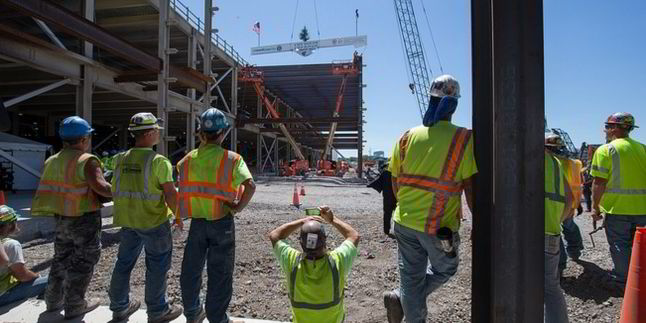The biggest immediate question is this: Does the “letter of intent” announced this past weekend mean Tesla would effectively throw in the towel on SolarCity’s own in-house PV manufacturing programme, and instead buy modules from Panasonic?
If that were the case, it would represent a major strategic pivot for SolarCity, which is the single largest employer in the US solar industry.
SolarCity branched out from its core business of rooftop panel installation into large-scale manufacturing through its 2014 acquisition of Silevo, a PV technology company based near SolarCity in Silicon Valley.
As part of that acquisition, SolarCity unveiled a hugely ambitious plan to build and operate the largest PV factory in the Western Hemisphere in Buffalo, New York, using hundreds of millions of dollars in state taxpayer money. The factory is due to begin production in 2017.
But Tesla’s latest announcement – revealed in a blog post on Sunday – suggests that rather than making SolarCity-branded panels, the Buffalo facility may essentially become a factory for Panasonic’s modules.
The "collaboration" with Panasonic is contingent on shareholders approving Tesla’s proposed acquisition of SolarCity in a vote scheduled for 17 November.
While much in Tesla’s latest announcement is vague, this line at least is unambiguous: “The parties intend for Panasonic to begin PV cell and module production at the Buffalo facility in 2017.”
In exchange, Tesla says it would provide a "long-term purchase commitment for those cells".
There’s no mention of any specific role SolarCity or Silevo would play in the manufacturing process. And far from spelling out how Silevo’s technology might be used by Panasonic, the announcement instead focuses on Panasonic’s own “industry-leading” cells and modules.
SolarCity did not immediately respond to a request for additional information.
Bringing Panasonic on board at the Buffalo factory has many obvious attractions for Tesla – not least in terms of the plant’s capital needs.
Although Elon Musk, chairman of both Tesla and SolarCity, insists his companies are not desperate need of cash as critics contend, it would clearly be helpful if Panasonic were to become a significant investor in the Buffalo factory – as the Japanese electronics giant already is with Tesla’s Gigafactory for lithium-ion batteries in Nevada.
SolarCity has always acknowledged that its push into manufacturing comes with significant risk. The global collapse in module prices over the past few months certainly does not put SolarCity's manufacturing strategy on any firmer ground.
Meanwhile, Panasonic recently outlined plans for a big push into the US solar market, where its high-efficiency cells and modules -- which marry monocrystalline and thin-film amorphous-silicon technologies -- work especially well in rooftop settings.
Panasonic currently manufactures its PV kit in Japan and Malaysia.
Even with Panasonic on board, SolarCity’s New York factory would have a slippery pathway forward.
In exchange for the state of New York investing more than $750m of public money into building the factory and kitting it out with production equipment, SolarCity committed to create nearly 1,500 jobs in Buffalo – and spend $5bn in the state over the next decade.
The news that Panasonic may join SolarCity in New York comes at a critical juncture for Tesla, as it races to convince its shareholders that an acquisition of loss-making SolarCity is in the company’s long-term interest.
On 28 October, Tesla and SolarCity are due to unveil a new solar roof product that they hope will shine a new light on their strategy of seamlessly integrating rooftop PV, home battery storage, and electric vehicles.
A few weeks after that, shareholders of Tesla and SolarCity will vote on the acquisition.
The possibility of Panasonic taking over manufacturing operations in New York is just one more factor shareholders will need to consider when deciding how to vote.

